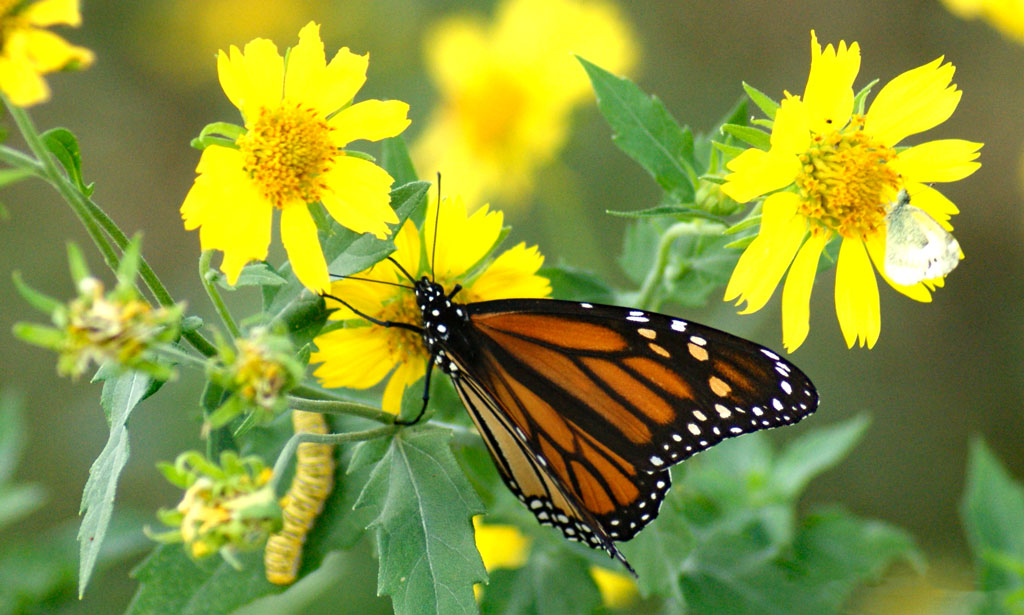
Learn how you can help protect the endangered monarch butterfly during its migration across Texas. Photo by Martelle Luedecke/Luedecke Photography
Monarch butterflies are on the International Union for Conservation of Nature's Red List, where they are now classified as endangered. Texas is a large portion of the monarch’s migration highway. We can help restore our beautiful hardworking pollinator friends. How you may ask?
Monarchs will travel through latitudes 29-31 the first three weeks of October. For the fall arrival, we can help by providing nectar for their long journey, roost for a rest, and water always. Plants that can provide energy fuel for their fall return flight to southwestern Mexico and the comfort of the oyamel fir trees are: autumn sage, Havana snakeroot (thoroughwort), frostweed, cowpen daisy, aromatic aster, Drummond's aster (Texas aster), willowleaf aster (tall aster), late purple aster (spread-leaf aster), and white heath aster. Plants for larger areas, according to MonarchWatch.org are: Texas barometer bush (cenizo), common buttonbush (shrub), and Maximillian sunflower.
Monarchs travel during the day and rest/roost at night. You might look out your door early one morning and see a tree filled with thousands of monarchs, perhaps close to a field or cluster of Maximillian sunflowers. Shhhh! They have a long trip, so let them sleep in.
In the spring, when the monarchs return, more help will be needed. Unfortunately, helping save the butterflies from extinction is not an overnight solution. Therefore, we reached out to Kristin Rodgers, who has helped and established native pollinator gardens in Burnet and surrounding counties.
POLLINATOR GARDENS
Monarch butterflies, like so many other pollinators worldwide, are in drastic decline for many reasons. Pesticides, disease, and habitat loss are largely to blame. This little butterfly that spreads pollen as it feeds on the nectar of wildflowers along its stunning 3,000-mile migration across North America each year needs our help.
And pollinator gardens are one vital way we can each do our part to help not just the monarch, but all pollinators. The good news: Anyone can help, and it doesn't take much money, time, or effort. Your pollinator garden can be as simple or as dynamic as you want.
Start by finding a suitable location that will provide food, water, cover, places to raise young, and sustainable practices. Bring in some fresh soil, maybe a little compost to kick it up a notch, and finish with a hearty native Texan pollinator seed mix and some water. And voila! If you plant it, they will come.
We started seeing butterflies, moths, and various other insects almost immediately once the flowers began to bloom. Then, we saw the lizards and birds — so many shapes, sizes, and colors. The diversity we attracted with our little start inspired us to do more.
There are many other native plants that can be added to your pollinator gardens, and the more diversity the more insects and other animals that will want to call it home. But there is nothing wrong with starting small. Did you know that just one oak tree can support over 500 species of moths and butterflies and provide shelter, cover, and places to raise young for so many other species?
By committing to create much-needed native habitat for the monarch butterfly and other pollinators, we can all make a small difference at home and in our communities. And this small difference adds up!
Till next time. Keep your souls and soles in your garden! Remember the True Master Gardener: Jesus said, “I am the vine; my Father is the Gardener.” John 15:1
"In the Garden" is written by daughter-father gardening team Martelle and Bill Luedecke. If you have gardening questions, contact Martelle at 512-769-3179 or luedeckephotography@gmail.com or Bill at 512-577-1463 or bill@texasland.net. Read more "In the Garden" columns in the 101 Lawn & Garden Guide.












